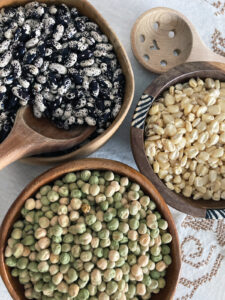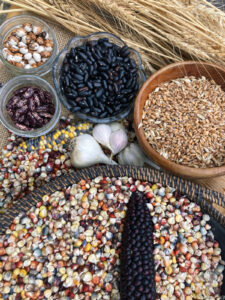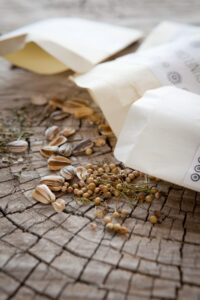Read one gardener’s reflections on why seed saving is important, and how closely connected humankind’s existence is with the plants we cultivate.
![]() This article is also available in audio format. Scroll down just a bit for the link and enjoy listening.
This article is also available in audio format. Scroll down just a bit for the link and enjoy listening.
A gardener’s work is never done. In spring, we plan our space and plant our seeds. We nurture our fragile seedlings, providing them with healthy soil, clean water, and warming sun. When summer’s heat begins to beat down upon our shoulders, we prune, trellis, and irrigate our precious plants. We weed and water and weed again in what seems like an eternal, uphill battle against grasses, plantains, and pigweeds. As fall arrives, baskets and bushels of colorful produce fill our kitchens as we begin to reap the bounty of our labors, harvesting, feasting, and preserving the garden’s bounty in preparation for the winter months ahead. And during winter, we plan and dream, fantasizing about the staggering array of diversity offered within the vividly colored pages of our favorite seed catalogs.
The heirloom gardener has much to enjoy for their efforts. There’s nothing more rewarding than the taste of homegrown produce: an heirloom tomato that you raised from a tender seedling, or a mighty winter squash destined to become a flavorful pie on your holiday table. The flavor of heritage fruits and vegetables is far superior to anything that can be found at the grocery store, and the selection of colorful and unique cultivars available to grow seems almost endless. With every season there comes a task, but perhaps no job is more important than that of the seed saver, who carries the spirit of our gardens from harvest, through the dormant winter and into spring, to once again be planted in the embrace of Earth’s warm soil.

Why Seed Saving Is Important
Saving our seeds is critical to preserving the heritage, cultures, and histories of all who have stewarded these precious crops before us. Without seeds, we would have no food, and early farmers understood that by selecting seeds from the biggest and best-producing plants in their fields, the yield of their harvests and the quality of their produce would continue to improve. In essence, these earlier farmers were the first plant breeders, and because of their efforts, we’re blessed with an incredible bounty of fruits and vegetables, with colors and flavors that delight the senses and enchant the imaginations of culinary artisans.
As seed savers, we do our part to preserve the work of these first farmers, honoring their time and dedication. Within each seed saved is the story of every gardener who grew that cultivar, and upon that seed lie the fingerprints of every grower who has ever entered into this sacred agreement of cultivation. And just as we care for these crops, fulfilling their needs in order to sustain their life, they in turn provide us with the nourishment we need to sustain ours. This reciprocal relationship doesn’t end at harvest; it carries on, through the seed, into the next season.

Audio Version
An Entwined Existence
This commitment is not to be taken lightly. Our follow-through is so critical, in fact, that to fall short of our responsibility is to endanger our very survival on this Earth. And the same holds true for the plants in our care. Entering into this agreement, known to botanists as “domestication,” these unique plants gave of themselves to provide us with their life-giving fruits and foliage. Through each passing season, as we selected the traits most valuable to us, these plants provided. But as we asked them for larger fruits, sweeter flavors, and more abundant leaves, other qualities — perhaps qualities that we may have viewed as less important — were altered and eventually lost.
Over time, these plants were changed from their wild selves to something new and different. It’s because of this exchange that many of today’s garden crops rely upon our care and attention; they’re far altered from their original wild forms and are unable to survive and thrive as they once could without the pruning, weeding, and irrigation that we’ve agreed to provide.

The same is to be said of our own species. Taking part in this sacred exchange has also changed us forever. Somewhere around 12,000 years ago, many of our ancestors began to shift away from their nomadic, hunter-gatherer behavior into a more settled, agrarian lifestyle. They began this shift by first learning to manage the wild places where their food plants already grew; they gave them space and urged them to thrive. Eventually, people began to coax these plants out of their habitats, observing their behaviors and selecting from the strongest and most productive species.
Nowadays, many of us no longer roam to follow the seasons, the migrating animals, and a ready supply of food, and instead live in constructed cities and towns, our own behavior forever altered. Just as these plants have allowed themselves to grow fully dependent upon our care, we now depend upon them. It’s only through cooperative cultivation that we’re able to prosper. Understanding the entwined nature of our relationship is paramount to success.
First Steps into Seed Saving
While modern plant breeding may appear to be limited to the realm of the scientist, small-scale farmers and backyard gardeners everywhere are still using the traditional techniques utilized by these earliest agrarians. This is only possible because of the heirloom, heritage cultivars being grown and saved in these small plots, known as “open-pollinated” (OP) cultivars. Generally speaking, this term refers to plants pollinated naturally by birds, insects, wind, or human hands.
To put it simply, seeds harvested from OP cultivars can be planted the following season and will come back “true-to-type,” meaning similar to the maternal plant. The gardener may need to take some additional precautions to avoid any cross-pollination with other plants, and these techniques and requirements vary for each species. The main point to understand here is that seed saved from OP cultivars can be grown again the next year with reasonable predictability.

Conversely, many modern cultivars available today are hybrids. A hybrid is produced when two plants of the same species are cross-pollinated to produce a new cultivar. This new cultivar is referred to as the “F1 hybrid.” While hybrids do offer a number of benefits, especially in today’s industrial food system, the seeds collected from these cultivars aren’t likely to grow true-to-type, and therefore aren’t ideal for the beginning seed saver.
Despite this, saving seeds from your garden is still relatively straightforward and can be accomplished by anyone with a bit of patience and practice. (See “Seed-Saving Best Practices,” below.) Remember, the first seed savers weren’t scientists or academic scholars, but they did take the time to observe and develop relationships with the plants in their care, the same plants that cared for them in return with nourishing fruits, flowers, and foliage.
The ancient practice of seed saving can deepen our garden experience and provide us with years of joy as we steward our favorite heirloom cultivars. When we save our seeds and share them with our friends, families, and communities, we become part of their story. Through seed saving, we preserve the past, while preparing for the future.

Seed-Saving Best Practices
Saving one’s own garden seeds can be an easy and rewarding practice for gardeners of all skill levels. Get started saving your seeds with these tips.
- Start small. Begin by saving seeds from only one or two crops. Try something that you already grow in your garden or that you enjoy eating.
- Save seeds from open-pollinated cultivars. These cultivars are more likely to come back true-to-type.
- The easiest garden crops to save seeds from are self-pollinating annuals. These species will produce flowers, fruits, and seeds all in one season, and are least likely to cross-pollinate with other cultivars.
- Seeds are mature and ready to be harvested when the fruits are ripe. Peppers, tomatoes, and other nightshades will change color to signal their ripeness, while crops such as beans and peas will grow dry and brittle.
- Properly label your seeds with the cultivar name, scientific name, and date of harvest.
- Clean your seeds well before storing them away for next season. Seeds should also be well-dried before you store them to avoid any mold from forming.
- Seeds store best when kept in a cool, dark, and dry environment. Glass jars are ideal for seed storage, but small envelopes or similar containers also work well.
- For long-term storage, keep your seeds in airtight containers in a freezer. When you’re ready to grow them, let your seeds reach room temperature before opening the containers to avoid getting your seeds wet through condensation.
Bevin Cohen is an author, herbalist, gardener, seed saver, educator, and owner of Small House Farm in Michigan. Bevin offers workshops and lectures across the country on the benefits of living closer to the land through seeds, herbs, and locally grown food, and he’s published numerous works on these topics, including the bestselling book Saving Our Seeds. Follow Bevin at Small House Farm.

In Saving Our Seeds, seed activist Bevin Cohen takes a deep dive into the modern seed-saving movement. Seed savers of all levels will benefit from Bevin’s easy-to-follow explanations on important seed-saving techniques, such as hand pollination, isolation, vernalization, and even basic flower structure.
This title is available at the Grit store or by calling 866-803-7096. Item #9960.
Get to know Bevin Cohen on our “Mother Earth News and Friends” podcast episode “The Artisan Herbalist.” In it, Bevin shares about his most recent book and about his work and passion for gardening, working with herbs, seed saving, and educating. Listen at Mother Earth News.




